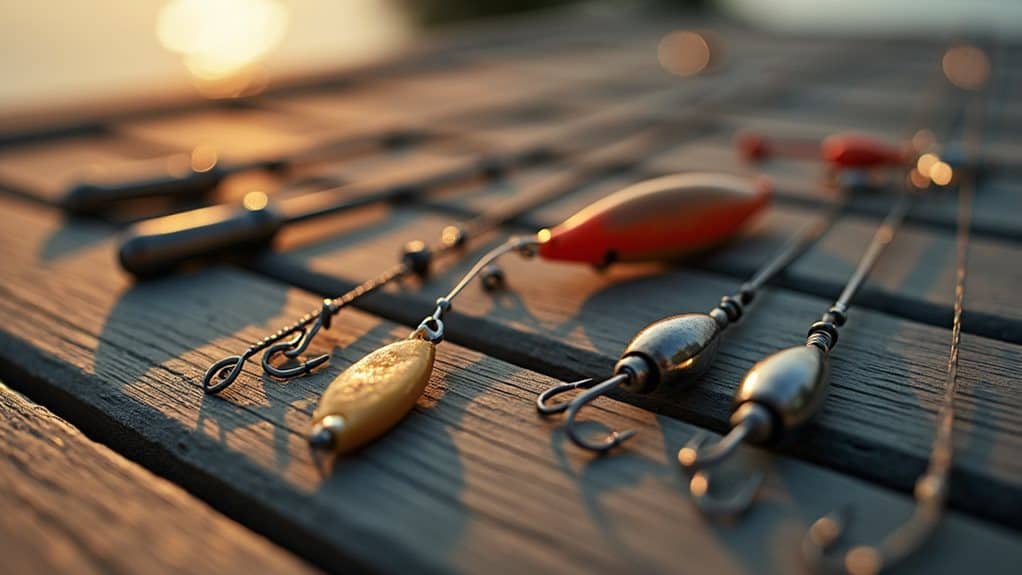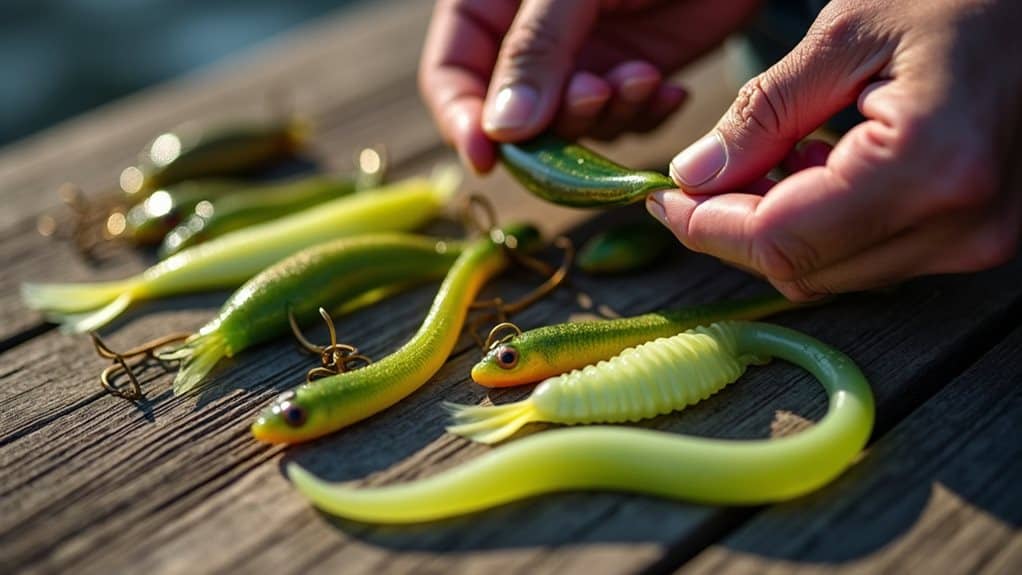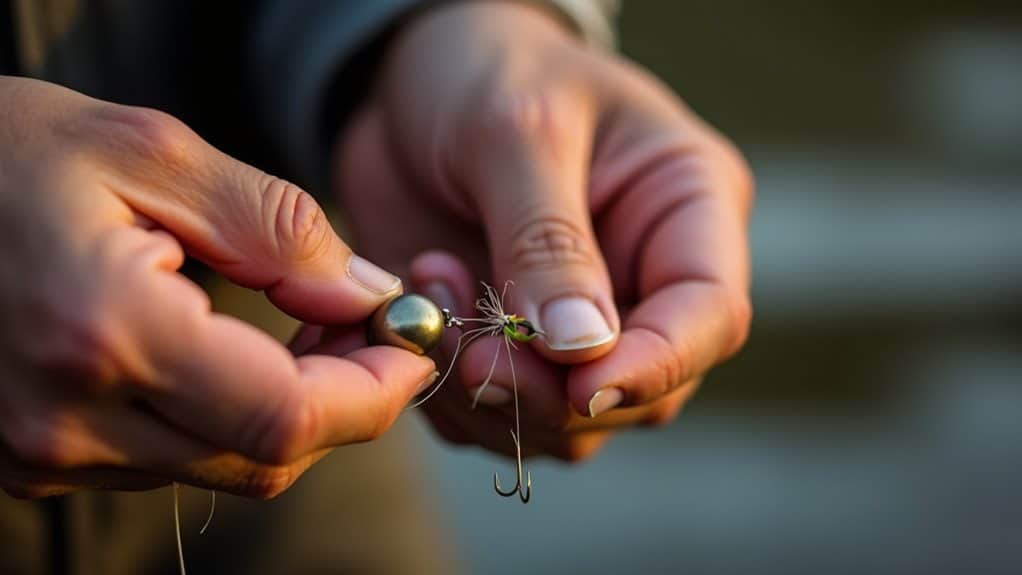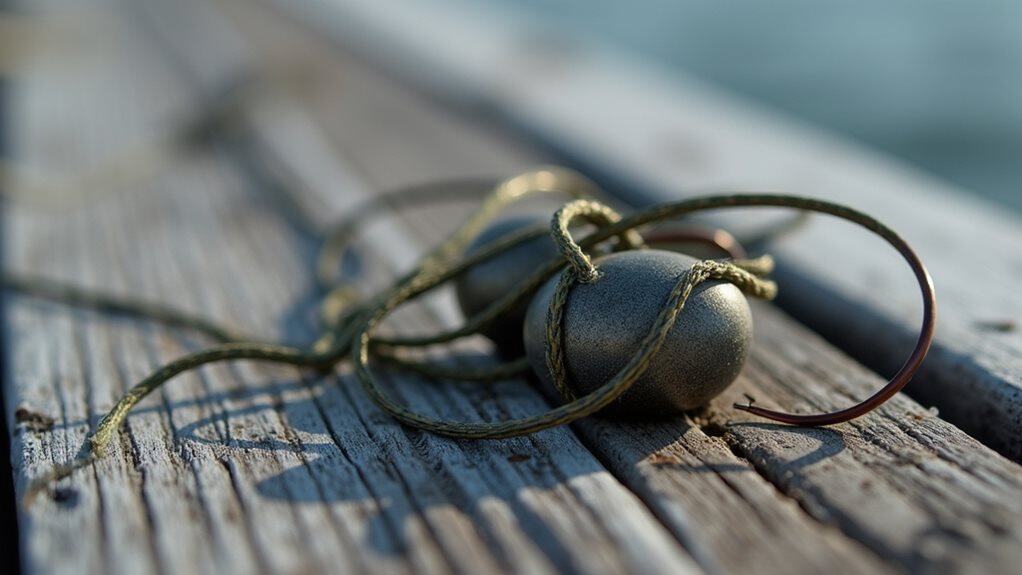To make a drop shot rig, you’ll tie a Palomar knot with your fluorocarbon leader, thread the tag end back through a size 2 drop shot hook from the point side, then attach a 1/8 to 3/8 oz weight 10-36 inches below. Nose-hook your soft plastic bait horizontally for natural presentation, using finesse worms or stickbaits for best results. This setup’s effectiveness depends on proper technique and understanding ideal conditions for maximum success.
TLDR
- Tie a Palomar knot with long tag end, then thread tag end back through hook eye from point side.
- Attach 1/8 to 3/8 oz weight at desired distance below the hook, typically 10-36 inches depending on conditions.
- Use size 2 Gamakatsu drop shot hook with small diameter braid and fluorocarbon leader for optimal sensitivity.
- Nose-hook soft plastic bait horizontally, using finesse worms, stickbaits, or soft minnows for natural presentation.
- Employ subtle rod tip movements with gentle lifts and pauses to create enticing bait action underwater.
Essential Components and Tackle Selection

When assembling a drop shot rig, you’ll need five essential components that work together to create an effective bass fishing setup.
Start with a size 2 Gamakatsu drop shot hook, add 1/8 to 3/8 oz weights, select soft plastics like Roboworm worms, use small diameter braid with fluorocarbon leader, and pair with a 7-foot medium-light spinning rod. This versatile setup proves effective across a wide range of depths ranging from shallow 1-foot areas to deeper 100-foot zones, making it ideal for both freshwater and saltwater fishing.
Step-by-Step Rigging Instructions
Five straightforward steps will change your tackle selection into a functional drop shot rig that’s ready to catch bass.
First, tie a Palomar knot with a long tag end, then thread it back through the hook eye from the point side. This knot is known for its strong connection to ensure your bait stays secure during fishing.
Next, attach your weight at the desired distance below.
Finally, nose-hook your soft plastic bait horizontally. This nose hooking technique provides better presentation and natural bait action in the water.
Choosing the Right Soft Plastic Baits

Which soft plastic bait will give you the best chance at fooling a bass into biting your drop shot rig? Straight tail finesse worms are your go-to choice, offering subtle, realistic action that appeals to finicky bass. In clear water, try 4-inch stickbaits for pressured fish, while soft minnows work when bass are feeding on baitfish. Additionally, consider using Texas-rigged plastics as effective alternatives, especially in habitats similar to those found in Lake Okeechobee.
Proper Hook Placement and Bait Presentation
The foundation of an effective drop shot rig lies in proper hook placement, which determines how naturally your bait moves through the water column. Nose-hook your soft plastic bait to create the most natural presentation possible. Adjust your leader length between 10 to 36 inches based on fish positioning and water depth, allowing easy height modifications for different conditions. Additionally, using a fish finder with CHIRP sonar technology can significantly enhance your ability to locate bass and improve your overall fishing success.
Effective Fishing Techniques and Rod Movements

Once you’ve rigged your drop shot properly, controlling the right rod movements will make the difference between watching fish swim by and actually catching them.
You’ll need to understand when subtle rod tip movements work best versus when dragging techniques will trigger more strikes from bass. The key lies in reading the situation and matching your presentation to what the fish want, whether that’s a barely-moving bait hovering above structure or a more aggressive dragging motion across the bottom.
Subtle Rod Tip Movements
Mastering subtle rod tip movements often determines the difference between a successful fishing trip and going home empty-handed when targeting bass with drop shot rigs.
You’ll want to use gentle, controlled motions to make your bait dance enticingly above the bottom. Quick, sharp movements can spook bass, while smooth lifts and pauses trigger strikes effectively.
Dragging Vs Stationary Techniques
When deciding between dragging and stationary drop shot techniques, you’ll need to contemplate water conditions, bass behavior, and the structure you’re fishing.
Dragging works best over hard bottom structures when targeting scattered bass, replicating a Carolina rig’s coverage.
Stationary techniques excel in clear, calm water where subtle presentations entice cautious fish without spooking them.
Optimal Water Conditions and Seasonal Applications
You’ll find that drop shot rigs perform exceptionally well in clear water conditions, where the finesse presentation and light fluorocarbon line create a natural, stealthy approach that doesn’t spook wary bass.
The technique really shines during colder months when bass metabolism slows down, making them more receptive to the subtle, controlled movements that drop shot rigs provide.
Clear water combined with cooler temperatures creates the perfect scenario for this finesse method, as bass can see your offering clearly while their reduced activity levels make them more likely to respond to precise, delicate presentations.
Clear Water Advantages
Clear water conditions offer distinct advantages for drop shot fishing, primarily through enhanced visibility that changes your approach to bass fishing.
You’ll spot bass before casting, enabling precise targeting of individual fish. This sight fishing capability lets you observe fish behavior, identify productive structure, and adjust your presentation accordingly.
However, clear water bass become more cautious and line-shy.
Cold Season Effectiveness
While clear water fishing presents its own advantages, the drop shot rig truly shines during cold season conditions when bass behavior shifts dramatically.
Your finesse presentation matches perfectly with lethargic bass that won’t chase fast-moving baits. The slow, precise movement keeps your bait in the strike zone longer, allowing cold-water bass to conserve energy while still tempting them into biting.
Troubleshooting Common Rigging Mistakes

Even experienced anglers can struggle with drop shot rigs when they make fundamental mistakes that sabotage their success on the water.
You’ll improve dramatically by using straight shank hooks with keepers, choosing 2500-3000 sized spinning reels, and employing subtle bait movements instead of aggressive jigging.
Target structure edges rather than centers, and always check your knots regularly.
Final Note
You’ve now perfected the fundamentals of drop shot rigging, from selecting proper tackle to executing effective presentations. Remember, this versatile technique shines in clear water and when bass are suspended or finicky. Practice your rigging until it becomes second nature, experiment with different bait colors and sizes, and pay attention to your rod’s sensitivity. With consistent application of these techniques, you’ll notice improved success targeting bass in various conditions and seasons.




